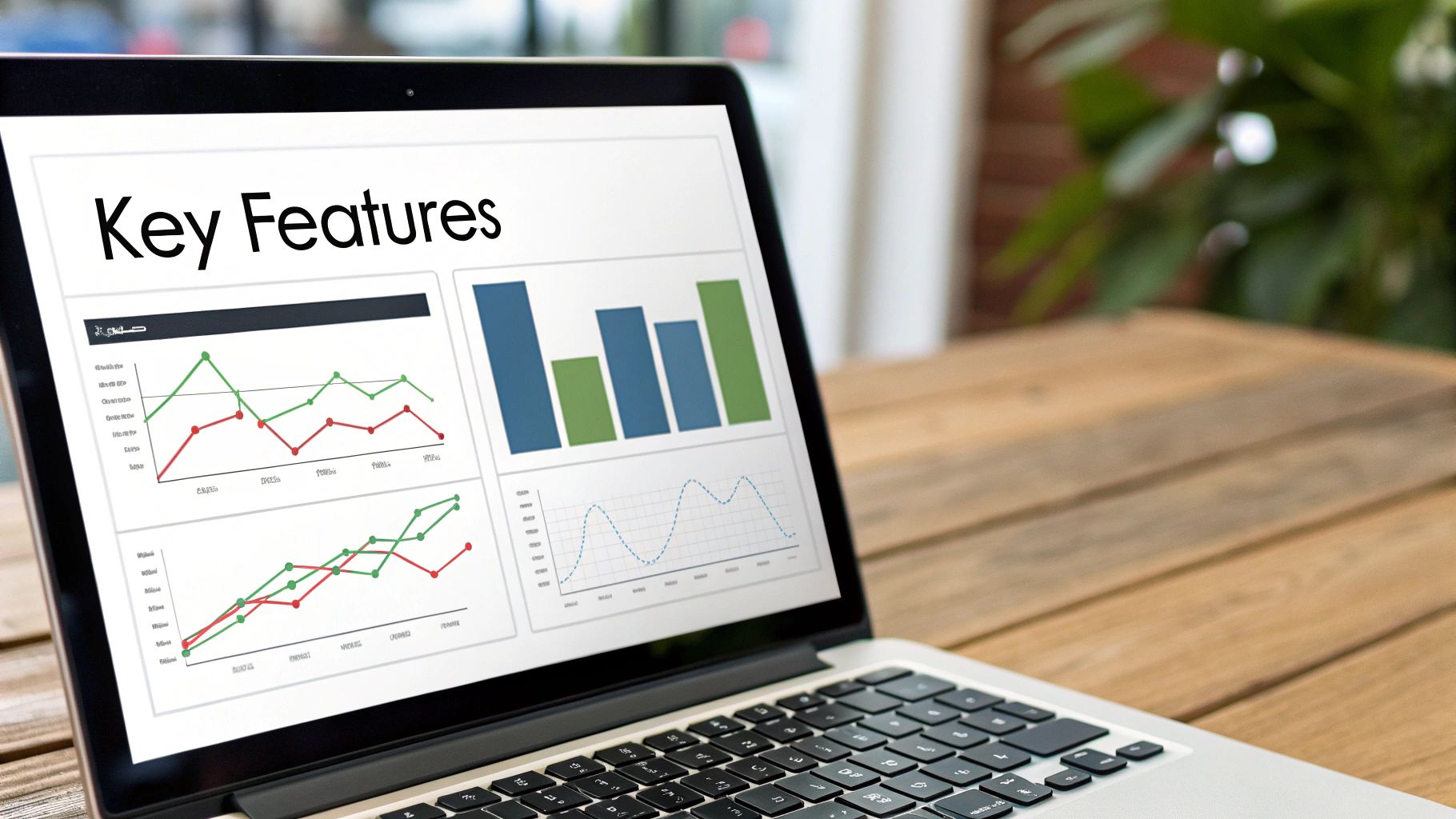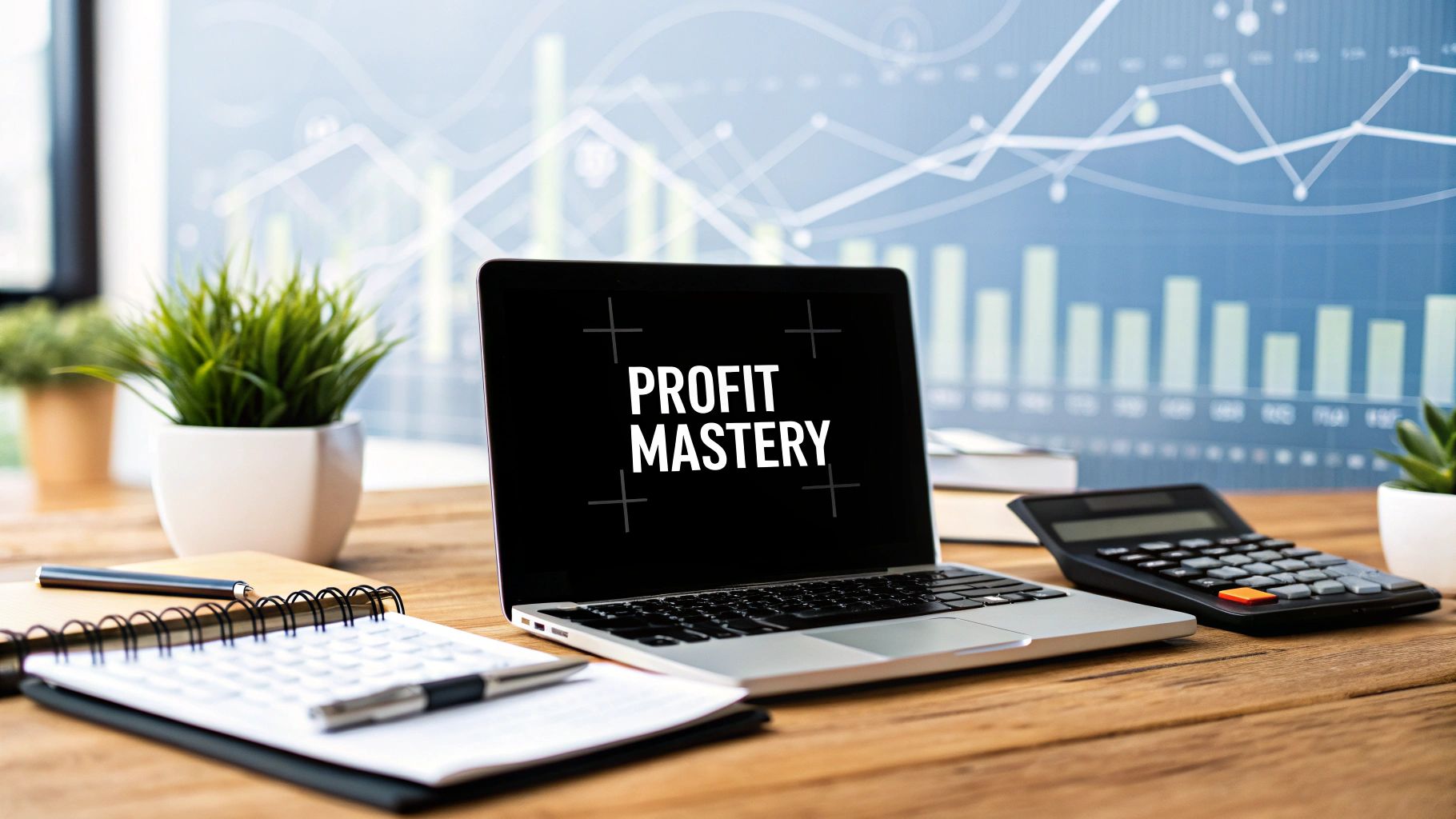Introduction To Online Profit Margin Calculator
An online profit margin calculator is a vital tool for any business operating in today's competitive landscape. It helps businesses accurately and efficiently determine the ideal selling price for their products or services to achieve their desired profit margin. This eliminates the guesswork involved in pricing, allowing you to focus on other important business operations. Understanding this tool and how to use it can have a significant impact on your business's profitability.
Why Use an Online Profit Margin Calculator?
There are several key advantages to using an online profit margin calculator. These calculators provide increased accuracy in pricing, ensuring you're neither underselling, which reduces potential profit, nor overpricing, which could deter customers. They also promote informed decision-making by providing a clear overview of your potential profitability. This is especially useful when evaluating various pricing strategies or when introducing new offerings to the market. This, in turn, gives your business a competitive advantage, allowing you to make data-driven pricing decisions and quickly adapt to changing market dynamics. A clear understanding of your margins also puts you in a stronger position when negotiating with suppliers.
How It Benefits UK Businesses
Online profit margin calculators are increasingly valuable for businesses in the UK, particularly with the continued growth of e-commerce. These tools allow entrepreneurs to pinpoint the optimal selling price for their products to reach their target profit margins. For instance, if a business aims for a 20% profit margin, the calculator can determine the correct selling price based on the cost of goods sold (COGS). If the COGS is £30, a 20% profit margin requires a selling price of £37.50. This is calculated by dividing the cost by 0.8 (derived from 1 minus the profit margin of 0.2). This simple calculation illustrates how accessible and easy-to-use online profit margin calculators are for UK businesses. Learn more about profit margin calculations here.

Key Features of Online Profit Margin Calculators
Most online profit margin calculators share common features that contribute to their user-friendliness:
- Cost of Goods Sold (COGS) Input: Enter the total cost associated with producing your product.
- Desired Profit Margin Input: Specify your target profit margin percentage.
- Selling Price Output: The calculator instantly displays the selling price required to achieve the specified profit margin.
- Real-time Calculations: Any adjustments to the input values immediately update the calculated selling price, facilitating quick "what-if" analysis.
These features enable businesses to explore different pricing scenarios and determine the optimal strategy for their products. This dynamic pricing allows businesses to respond effectively to market fluctuations and maximize their profit potential.
Analyzing Profit Margins Across Industries
Understanding profit margins is crucial for any business. This knowledge is especially important when comparing your performance to industry averages. Looking at profit margins across different sectors reveals how much industry dynamics can impact potential profitability. Some industries naturally operate with smaller margins than others due to factors like competition and operational costs.
The Impact of Competition and Costs
Highly competitive industries, like retail, often have lower profit margins. This is because of the constant pressure to keep prices low and the high operational costs, such as rent, staffing, and inventory. On the other hand, specialized industries with unique products or services, like software development or niche manufacturing, often have higher profit margins. These businesses can charge premium prices because of the unique value they offer. Understanding your industry’s typical margin landscape can help you develop a smart pricing strategy.
In the UK, average profit margins can vary significantly. Retail businesses often operate with lower margins due to high competition and costs. However, industries with unique products or services, such as technology and software, can enjoy higher margins. A study by Osome emphasizes the importance of understanding gross and net profit margins to assess business profitability. For example, a company with a gross profit margin of 30% might only have a net profit margin of 10% after factoring in operating expenses, interest, and taxes.
To help illustrate these differences, let's take a look at a comparison of industry profit margins.
Industry Profit Margin Comparison:
A detailed comparison of average gross and net profit margins across various industries, designed to help businesses benchmark their performance effectively.
| Industry | Gross Margin | Net Margin | Notes |
|---|---|---|---|
| Retail | 25% | 5% | Highly competitive, high operational costs |
| Software | 80% | 25% | Specialized skills, high value product |
| Food Service | 60% | 10% | Perishable goods, fluctuating ingredient costs |
| Manufacturing (Niche) | 40% | 15% | Specialized products, potential for higher pricing |
| Manufacturing (General) | 30% | 8% | High competition, price sensitivity |
As this table demonstrates, understanding both gross and net profit margins is crucial for evaluating business performance within a specific industry context. While gross margin shows the profitability of production, net margin provides a more comprehensive picture of overall profitability.
Gross vs. Net Profit Margins
It’s important to understand the difference between gross and net profit margins. Gross profit margin is the percentage of revenue left after subtracting the direct costs of producing goods or services (COGS). It shows how efficient your production process is. Net profit margin, however, provides a more complete view. It includes all expenses, such as operating costs, interest, and taxes. It shows your business's overall profitability after all costs are considered. This difference can be substantial, as the Osome example highlights. Using an online profit margin calculator that analyzes both metrics gives you a better understanding of your financial performance.
Benchmarking and Improvement
Analyzing profit margins across industries lets you benchmark your performance against competitors and identify areas for improvement. This information helps you with pricing decisions, finding a balance between profitability and competitive pricing. Using an online profit margin calculator allows you to test different price points and cost structures. This helps you see how they affect your margins. This data-driven approach lets businesses optimize their financial strategies for the best possible profitability within their specific industry.
How Online Profit Margin Calculators Work
Online profit margin calculators simplify product pricing for profit. These tools use straightforward math formulas to help businesses quickly and accurately determine the optimal selling price, covering costs, achieving target profit margins, and remaining competitive. But how do these calculators work behind the scenes?
The Core Formula
At the heart of every online profit margin calculator is a simple yet powerful formula. This formula calculates the selling price based on the cost of goods sold (COGS) and the desired profit margin. One key aspect involves subtracting the desired profit margin (expressed as a decimal) from one. This result is then used to divide the COGS, ultimately yielding the selling price.
For example, if you want a 20% profit margin and your COGS is £50, subtract 0.2 from 1 (getting 0.8), then divide £50 by 0.8. This gives you a selling price of £62.50.
Input Variables and Their Influence
Online profit margin calculators consider several key input variables. The most crucial are the COGS and the desired profit margin. Adjusting the desired profit margin directly impacts the calculated selling price. A higher profit margin leads to a higher selling price, while a lower margin results in a lower price.
Similarly, changes in COGS directly affect the final selling price. Higher COGS necessitates a higher selling price to maintain the desired margin. The need for businesses to quickly adjust pricing strategies in response to market conditions has influenced the development of online profit margin calculators.
These tools allow companies to input costs and desired profit margins to calculate the optimal selling price. Shopify's profit margin calculator, for example, helps businesses set ideal product prices to enhance profitability. Using such calculators helps businesses cover costs, earn their desired profit, and stay competitive. Explore this topic further.

From Manual to Digital: A Comparison
Traditional manual pricing methods were often tedious and error-prone, making it difficult for businesses to adjust prices quickly to changing market conditions. Online profit margin calculators offer a streamlined and reliable approach.
They provide instant calculations and "what-if" analysis, letting businesses explore various scenarios and make informed decisions in real-time. This increased speed and accuracy translates to greater control over pricing and a stronger bottom line.
Different Types of Profit Margins
Online profit margin calculators can be designed for various types of profit margins, including gross profit margin, operating profit margin, and net profit margin. Understanding the difference between these types is crucial for selecting the right calculator and interpreting the results.
- Gross profit margin: Considers only the direct costs of production.
- Operating profit margin: Accounts for direct costs and operating expenses.
- Net profit margin: The most comprehensive, including all costs and expenses, offering the clearest view of overall profitability.
Many calculators allow selecting the desired margin type, providing flexibility for different business needs and financial analysis.
Pricing Strategies Using Online Profit Margin Calculator
An online profit margin calculator is more than just a number cruncher; it's a powerful tool for strategically setting prices to maximize your profits. It helps businesses translate raw cost data and desired profit margins into well-informed pricing decisions. This involves understanding your costs, setting realistic profit goals, and analyzing the impact of different price points on your bottom line.
Setting the Right Price
Finding the sweet spot for your product's price requires a delicate balance. You need to cover your costs, reach your profit targets, and stay competitive. An online profit margin calculator helps you achieve this balance by letting you explore different scenarios. Input your cost of goods sold (COGS) and your target profit margin, and the calculator will instantly produce the corresponding selling price. This allows for quick and easy "what-if" analysis, which is essential for dynamic pricing.
Responding to Market Dynamics
Markets are in constant flux. Competitor activity, changes in demand, and even seasonal shifts can influence the ideal price for your products. An online profit margin calculator empowers you to adapt swiftly to these changes. For example, if a competitor drops their price, you can use the calculator to figure out how to adjust your own pricing to maintain profitability while remaining competitive. Understanding profit margins is crucial for businesses in the UK to assess financial health and make sound decisions. Profit margins are often benchmarked against industry averages. For instance, a high profit margin typically means a company is efficient at generating profit relative to its revenue. Conversely, a low profit margin could indicate high operating costs or inefficiencies. Businesses use profit margin calculators to monitor and refine their pricing strategies, ensuring they remain competitive and profitable. For more detailed information on UK businesses and profit margins, see Equals Money's insights.
Aligning Pricing With Business Goals
Your pricing strategy should always support your overall business objectives. Whether your focus is maximizing profit, expanding market share, or building a premium brand, your pricing decisions are key. An online profit margin calculator can help you model different scenarios to identify which price points best align with your strategic goals. For example, if you’re launching a new product and aiming for rapid market penetration, you might choose a lower profit margin initially to attract customers.
Utilizing Different Pricing Strategies
Several pricing strategies can be used effectively with an online profit margin calculator:
- Cost-plus pricing: This involves adding a fixed percentage markup to your COGS.
- Value-based pricing: This focuses on the perceived value of your product to the customer.
- Competitive pricing: This involves setting prices relative to your competitors’ prices.
The calculator allows you to quickly model each strategy and see how it affects your potential profit.
To help you choose the right online profit margin calculator for your needs, let's look at a comparison of a few popular options:
Online Profit Margin Calculator Comparison
A side-by-side evaluation of popular online profit margin calculators, outlining their key features, user-friendliness, and pricing to help you choose the best tool for your business.
| Calculator Name | Key Features | Ease Of Use | Cost |
|---|---|---|---|
| Shopify's Profit Margin Calculator | Calculates gross profit, net profit, and profit margin. Simple interface. | Very Easy | Free |
| GoodCalculators.com Profit Margin Calculator | Offers various profit margin calculations, including markup and discounts. | Easy | Free |
| CFI's Profit Margin Calculator | More advanced calculations for experienced users. Allows for detailed cost inputs. | Moderate | Free |
| CalculatorSoup Profit Margin Calculator | Provides breakdowns of different profit margins (gross, operating, net). | Easy | Free |
As you can see, there are many free and easy-to-use profit margin calculators available. Choosing the right one depends on your specific needs and the complexity of your calculations.
Integrating The Calculator Into Your Workflow
For sustained growth, incorporate an online profit margin calculator into your daily financial planning. This enables you to continuously monitor your margins, spot trends, and proactively respond to market changes. By regularly using the calculator, you'll gain a deeper understanding of your cost structure, profit drivers, and optimal price points. This data-driven approach ensures your pricing decisions are always informed and strategically aligned with your business objectives. Consider tools like Mergo for more comprehensive sales and profit tracking, especially if you sell on platforms like TikTok Shop. This provides a powerful platform for optimizing pricing and boosting your bottom line.
Enhancing Profit Margins With Automation

Automation is significantly changing business operations, especially its impact on profit margins. Integrating automation, particularly through Artificial Intelligence (AI), allows companies to substantially cut operational costs and boost efficiency. This directly leads to a healthier bottom line and strengthens competitive advantage.
The Power of AI in Customer Service
Automation has a profound impact on customer service. AI-powered chatbots and virtual assistants handle high volumes of routine customer inquiries, freeing up human agents for more complex issues. This not only reduces staffing costs, but also improves response times and customer satisfaction.
Imagine a chatbot instantly providing order tracking information or answering FAQs. This allows human agents to handle returns or specific product inquiries. This streamlined approach elevates the customer experience while improving efficiency.
The integration of AI and automation in customer service, as suggested by Zendesk, can significantly impact profit margins. Optimizing operations and enhancing customer experiences are key. Streamlining support processes helps reduce operational costs and increase average order values, thereby improving profit margins.
AI-powered tools can identify high-margin products and prioritize them in marketing strategies. This not only boosts revenue but also allocates resources efficiently to maximize profitability. Learn more about AI and profit margins here.
Data Analytics for Smarter Decisions
Automation plays a crucial role in data analytics. AI-powered tools analyze large volumes of data to identify trends, predict customer behavior, and optimize pricing strategies.
This data-driven approach empowers businesses to make informed decisions. Product development, marketing campaigns, and inventory management can all be improved, contributing to increased profitability.
Imagine an AI system analyzing sales data to pinpoint the highest profit margin products. It can then automatically adjust marketing spend to promote those products more effectively. This level of automation allows for dynamic, responsive business strategies.
Streamlining Marketing Strategies
Automation can significantly streamline marketing efforts. Targeted advertising campaigns, automated email marketing, and personalized product recommendations help businesses reach the right customers with the right message at the right time.
This focused approach reduces wasted marketing spend and increases the chance of conversions. For example, an e-commerce platform can use AI to analyze browsing history. This allows it to recommend related products customers are more likely to purchase, increasing sales and strengthening customer engagement and loyalty.
Optimizing Resource Allocation
Automating routine tasks allows businesses to optimize resource allocation. Employees can then focus on high-value activities that directly contribute to growth. Strategic planning, product development, and customer relationship management are a few examples.
This shift allows businesses to operate more efficiently and achieve better results using the same, or even fewer, resources.
Adapting to Market Changes
In today’s fast-paced environment, adapting quickly to market changes is essential. Automation lets businesses monitor market trends, analyze competitor activities, and adjust strategies in real-time. An online profit margin calculator can be integral to this, allowing businesses to quickly assess the impact of changing costs or pricing on profit margins. This agility keeps businesses ahead of the curve and maintains profitability, even in challenging market conditions. This responsiveness is invaluable for maintaining a competitive edge.
Conclusion And Best Practices

This guide has explored the power and utility of the online profit margin calculator. This tool is essential for accurate pricing and informed business decisions that ultimately lead to increased profitability. This final section summarizes the key takeaways and offers best practices for integrating this valuable tool into your business operations.
Key Takeaways
-
Accurate pricing is the cornerstone of business success. Underpricing can significantly impact potential revenue, while overpricing can drive customers away. An online profit margin calculator helps find the sweet spot – the optimal price point that maximizes profit while remaining competitive.
-
Understanding industry benchmarks is crucial for long-term success. By comparing your profit margins to industry averages, you can identify areas for improvement and refine your pricing strategies to remain competitive.
-
Automation offers substantial advantages in today's fast-paced business environment. Integrating automation can streamline your operations, reduce costs, and optimize resource allocation, all contributing to healthier profit margins.
Best Practices for Using an Online Profit Margin Calculator
-
Regular Monitoring: Setting prices and then neglecting them can be detrimental to your bottom line. Regularly review and adjust your pricing strategy with the calculator, particularly when your costs fluctuate or market conditions change. This proactive approach will help you maintain optimal profitability.
-
Consider All Costs: For a truly accurate calculation of your cost of goods sold (COGS), remember to factor in all related expenses. This includes materials, labor, shipping, and even marketing costs. A comprehensive view of your costs ensures your pricing is genuinely profitable.
-
Experiment with Different Scenarios: Online profit margin calculators allow for quick "what-if" analysis. Explore different price points and cost structures to understand their impact on your margins, enabling you to make data-driven decisions.
-
Integrate with Business Goals: Your pricing strategy should align with your overall business objectives. Whether your goal is to maximize profit or expand market share, the calculator can help you determine the right price point to support your chosen strategy.
By implementing these best practices and utilizing the power of the online profit margin calculator, businesses can achieve a deeper understanding of their financials, optimize their pricing strategies, and drive sustainable growth.
For TikTok Shop sellers looking to enhance their profit tracking and gain deeper insights into their sales data, consider Mergo. This platform offers a comprehensive dashboard and real-time analytics specifically designed for TikTok Shop, empowering sellers to optimize their operations and boost profitability.

Leave a Reply